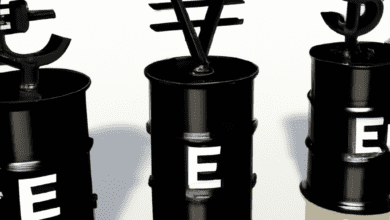Currency Exchange Unveiled: The Interplay of Interest Rates, Geopolitics, and Trading Strategies

In the ever-evolving world of foreign exchange (forex) trading, understanding the intricate relationships between interest rates, geopolitical events, and currency values is crucial for investors and traders alike. Interest rates, set by central banks, play a pivotal role in determining currency exchange rates, influencing everything from global trade to investment flows. As geopolitical tensions rise and fall, they create ripples across forex markets, affecting major currency pairs such as EUR/USD and GBP/USD in ways that can be both predictable and surprising. Furthermore, inflationary pressures shape trading strategies, while innovative concepts like carry trading leverage interest rate differentials to maximize profits. With the advent of digital currencies, traditional forex markets are also undergoing a significant transformation, prompting traders to adapt their strategies accordingly. In this article, we will delve into these themes, exploring how interest rates and geopolitical dynamics shape the forex landscape, and provide insights into effective trading strategies informed by economic indicators.
- 1. **Interest Rates and Currency Exchange: A Complex Relationship**
- 2. **Geopolitical Dynamics: Shaping the Forex Landscape**
- 3. **Navigating Forex Trading: Strategies and Economic Indicators**
1. **Interest Rates and Currency Exchange: A Complex Relationship**
Interest rates play a crucial role in determining currency exchange rates, creating a complex and often dynamic relationship between the two. When a country's central bank raises interest rates, it typically attracts foreign capital seeking higher returns on investments. This influx of capital increases demand for the domestic currency, leading to its appreciation. Conversely, when interest rates are lowered, the opposite effect can occur; capital may flow out of the country, resulting in depreciation of the currency.
The relationship between interest rates and exchange rates is further influenced by market expectations. Traders often react not only to current interest rates but also to anticipated changes in monetary policy. For instance, if investors believe that a central bank is likely to raise rates in the future, they may start buying the currency in advance, driving up its value. This speculative behavior can create significant volatility in the forex market.
Additionally, the impact of interest rates is magnified by geopolitical events and economic conditions. For example, during periods of economic uncertainty or geopolitical instability, investors may seek safe-haven currencies, which can lead to fluctuations that are not directly correlated with interest rate changes. Thus, while interest rates are a fundamental driver of currency exchange, they operate within a broader context of economic data, investor sentiment, and geopolitical developments. This interplay makes it essential for traders to consider a range of factors when analyzing currency movements and developing trading strategies.
2. **Geopolitical Dynamics: Shaping the Forex Landscape**
Geopolitical dynamics play a crucial role in shaping the forex landscape, as they influence market sentiment and the perceived stability of economies. When significant political events occur—such as elections, conflicts, trade negotiations, or changes in government policies—they can lead to fluctuations in currency values. Traders closely monitor geopolitical developments, as they often serve as indicators of economic stability and future monetary policies.
For instance, tensions between countries, such as trade wars or military conflicts, can result in increased volatility in currency pairs. Safe-haven currencies, such as the US dollar and Swiss franc, tend to appreciate during times of geopolitical uncertainty, as investors seek to protect their assets. Conversely, currencies from countries involved in conflicts may depreciate due to heightened risks and potential economic fallout.
Additionally, geopolitical events can prompt central banks to adjust their monetary policies in response to changing economic conditions. For example, if a country faces sanctions or trade disruptions, its central bank may lower interest rates to stimulate growth, leading to a weakening of its currency. Conversely, a stable geopolitical environment can bolster investor confidence, attracting foreign investment and strengthening the local currency.
Market participants also assess the potential impact of geopolitical events on trade relationships and economic performance. For instance, a new trade agreement between major economies could enhance trade flows, benefiting currencies involved in the agreement. As such, forex traders use geopolitical analysis as a vital component of their decision-making process, enabling them to anticipate currency movements and adjust their strategies accordingly.
In summary, understanding geopolitical dynamics is essential for navigating the forex market. Traders who can effectively interpret how political events influence economic conditions and investor sentiment are better positioned to capitalize on currency fluctuations and manage risks.
3. **Navigating Forex Trading: Strategies and Economic Indicators**
In the complex world of forex trading, successful navigation requires a solid understanding of various strategies and economic indicators that can influence currency movements. Traders often employ a combination of technical analysis, fundamental analysis, and market sentiment to make informed decisions.
One of the core strategies in forex trading is trend following, where traders identify and capitalize on established market trends. This approach relies heavily on technical indicators such as moving averages and the Relative Strength Index (RSI), which help traders gauge momentum and potential reversal points. By recognizing trends early, traders can position themselves to benefit from sustained price movements.
Another important strategy is range trading, applicable in markets where currencies fluctuate within a defined range. Traders look for support and resistance levels, buying at the lower end and selling at the upper end of the range. This strategy can be particularly effective in stable market conditions or during periods of low volatility.
Economic indicators play a critical role in shaping trading strategies. Key indicators include Gross Domestic Product (GDP), employment reports, inflation rates, and central bank announcements. For instance, a stronger-than-expected GDP report often signals economic growth, leading to currency appreciation. Conversely, disappointing employment figures may result in currency depreciation as traders adjust their expectations for future economic performance.
Additionally, inflation indicators, such as the Consumer Price Index (CPI), provide insights into price stability and purchasing power, influencing central bank policies. Traders closely monitor these indicators to anticipate monetary policy shifts that could affect interest rates and, subsequently, currency values.
Incorporating economic calendars into trading plans is essential. These calendars outline the release dates of key economic indicators and events, allowing traders to prepare for potential market volatility. By aligning trading strategies with the timing of these releases, traders can better position themselves to capitalize on market reactions.
Ultimately, successful forex trading requires a blend of strategic planning and adaptability. By leveraging both technical strategies and economic indicators, traders can navigate the dynamic forex landscape and make informed decisions that enhance their chances of success.
In conclusion, the interplay between interest rates, geopolitical events, and economic indicators creates a complex and dynamic environment for currency exchange rates. As we have explored, interest rates significantly influence currency values, with traders often leveraging this relationship through various strategies, including carry trading. Geopolitical events further complicate this landscape, as they can lead to sudden shifts in market sentiment and currency valuation.
For traders navigating major currency pairs like EUR/USD and GBP/USD, a keen understanding of central bank policies and inflation trends is essential for developing effective trading strategies. Moreover, the rise of digital currencies introduces new variables into the traditional forex markets, challenging traders to adapt and innovate. By utilizing economic indicators as predictive tools, traders can better position themselves to capitalize on currency movements in this ever-evolving market.
Ultimately, the forex market remains a multifaceted arena where informed decision-making and strategic planning are key. As investors continue to adapt to changing conditions, staying aware of the intricate relationships between these factors will be crucial for achieving success in currency trading.





